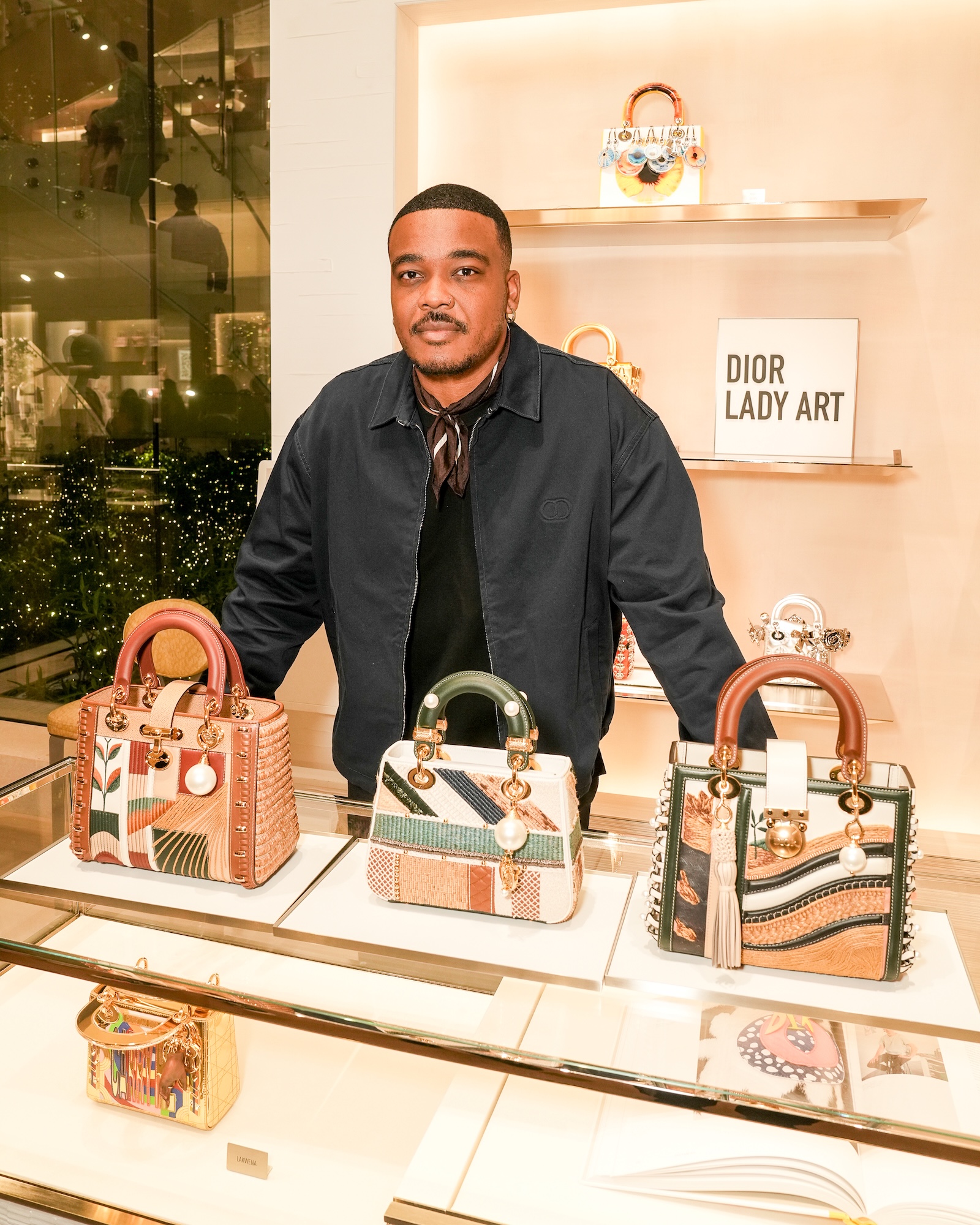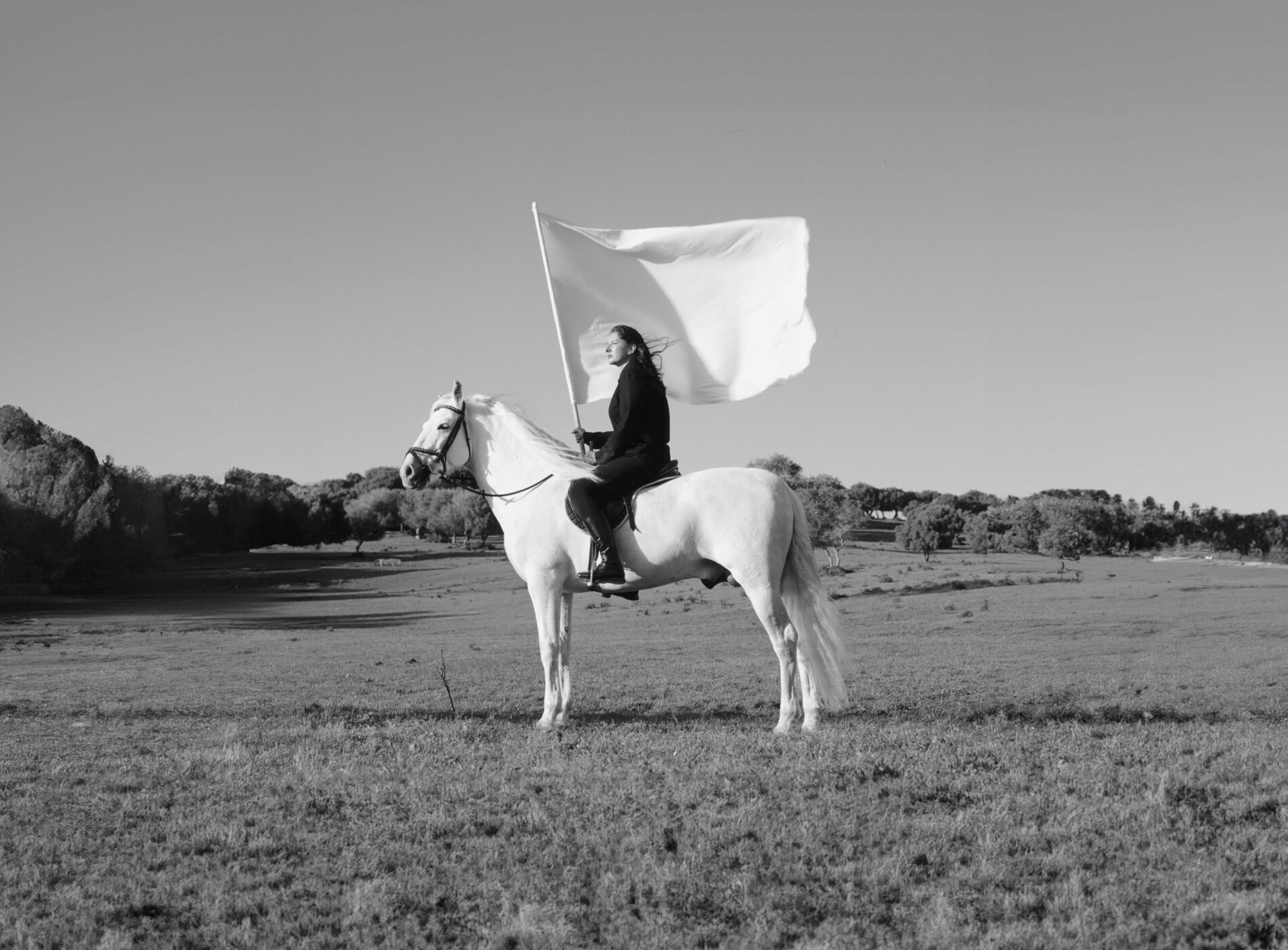The temperature hovers above 90 degrees off a sleepy alley in Pasadena, and I don’t know where to go. I notice, emblazoned on
a brick building, is the name _PASHGIAN._ Approaching the door,
I knock, and a man appears from a heap of rugs inside. The man grins. He’s been asked this question a million times. “Over there,” he says, pointing to a building on the other side of the lot. No sign, no name, just a faded blue door. I ring the bell in vain. Getting nervous, I call Helen Pashgian.
“I’m almost there! Be there in a few minutes,” she says, alleviating my stress. It’s refreshing when an artist encourages you to contact them directly, rather than navigating the oftentimes stuffy communication process via representatives and assistants. She’s just spoken a few words, but it’s this ease, candor, and humanness that proves to be a harbinger for our imminent studio visit. When Helen arrives, she greets me warmly and we immediately take shelter in the cool and shade that her studio offers.
“Close your eyes,” she tells me. Despite the uncertainty and disorientation, I oblige. She guides me into a room, shuts the door, and pauses for a few moments. “Okay, you can open them.” In front of me is a large yellow smudge, suspended in the air, equally striking and present as it is ethereal and translucent. You know that feeling as a child when you saw something, _anything,_ that was unfamiliar, or inexplicable, and it became seared in your memory? I got that feeling a lot when seeing new movies—perhaps ones that were too conceptual, beyond my years. It was a feeling of bewilderment; neither bad nor good, just _something._ Sitting silently in the dimly-lit room, staring at the yellow smudge, for the first time in a long, long time, that feeling washes over me.


HELEN PASHGIAN photographed in her studio.
“I’ve been trying to achieve something like this since the ‘70s,” confides Helen. At that moment, I’m not sure what to say or do, because I’m confronted with something I’ve never really seen before. “It doesn’t confront you in a bad way,” she continues. “It’s comforting. The world we live in is so fast...this is contemplative. It’s timeless. It belongs to no culture.” While it seems Pashgian is referring to the seemingly weightless, but actual 250-lb epoxy resin disc placed on a pedestal, the truth of the matter is, that isn’t the case. In fact, that alluring yellow smudge, that _egg yolk_, is not even the centerpiece.
“I’m interested in disembodied light,” she declares. “This is about looking at objects, and having _light_ change, alter and dematerialize them.” Pashgian holds a small remote control and begins dimming the lights, rendering the yellow smudge even more faint, more nonexistent. An apparition. Where the disc begins and where it ends is indistinguishable. Quickly, she raises the dial on high to full potential. Now we are looking at the sun, and it is nourishing. “Go ahead, walk around it,” she says, invitingly. “It’s a lens just like the lens in your eye.”
Helen Pashgian’s curiosity to explore the limits, capabilities, and effects of light, and her commitment to employ and alter materials as mediums to channel light and observe its unadulterated agency, continuously, for all these years, is astonishing. Curiosity and commitment, though, can’t be the only forces in this lifelong pursuit to harness light and dematerialize, deconstruct, and denude objects. _Seduction,_ a feeling as anthropological and honest as it gets, is another piece to this career-spanning-sixty-years pie. Trained as an art historian specializing in the Dutch Golden Age, Pashgian was no stranger to the 17th-century painters in Leiden or Delft who also strove to shine a little light. “Whether you were an oil painter, or a sculptor \[like myself\], we were all interested in light.” Yes, Rembrandt and Vermeer, too, were seduced by the sun—just look at the latter’s painting, _The Astronomer_. The same can be said of Pashgian, yet here, she has tamed it in her studio. It’s placed on a pedestal. Perfection.
The Light and Space movement of Southern California in the ‘60s and ‘70s was just as much a product of the surrounding environment as it was a product of new and available materials. For Pashgian, born and raised in Pasadena in the 1930s, the San Gabriel Mountains towered over the still-provincial, nascent town, a constant reminder of nature’s physical superiority over the worldly desires of new settlers from far and wide. In 1970, during a residency at nearby Caltech, Pashgian began experimenting with industrial materials, notably plastics, epoxy resins, and polyester resins—drawn to their effective response to sanding and other types of modification. Unlike years in the past, when fabricating something as rudimentary as a small, clear and translucent object from a traditional material like glass was virtually impossible, a new era flourishing from the technological spoils of World War victory—where substances that were once classified by military blacksuits were soon rendered declassified and geared for market exploitation—opened the floodgates for material possibilities.
Pashgian, like her contemporaries including Peter Alexander and De Wain Valentine, marveled at the realization that they could shape these materials into their vision, to play with color, but most importantly, to engage with, and access, light. They, too, could harness the sun. But you had to make sure you didn’t stare too long. “These materials were very seductive, particularly at the beginning, and almost anything they did was exquisite for the moment,” she says. “You could be seduced into letting it do what you wanted it to do. You couldn’t allow yourself to do that... you had to be very disciplined and stick to what you wanted to achieve...Otherwise, you could just be all over the place.”
Who knew resin could do that to a person? The discipline that Pashgian describes references the painstaking quality- control that artists who ventured into the world of resins undertook. Sanding, finishing, and color mixing (with eye droppers, no less) were just a few of the processes that Pashgian enlisted to ensure a pristine and immaculate surface. “I have to be diligent,” Pashgian admits. “There are about sixty steps involved and none of them are written down, it’s all in my head. I have to be doing everything perfectly, not cutting any corners... or something will go wrong, one thing will throw off the entire piece. It’s aesthetically challenging and it’s physically difficult, but it’s very, very exciting.” I immediately envision the perfection of fellow Light and Space artist John McCracken’s monolithic sculptures. Man, those _are_ smooth. These steps aren’t merely prerequisites for the material, they are a _reverence_ reserved for something greater. Something worthy to channel an even more crucial entity. _Hint:_ it starts with an ‘L’.


HELEN PASHGIAN “Untitled (orange)” 2009. Formed orange acrylic with acrylic elements. 91 x 17.5 x 20 in. Courtesy the artist and Lehmann Maupin, New York, Hong Kong, and Seoul. Photo: Joshua White.
Outside the groovy bubble that was Southern California in the ‘60s and ‘70s were folks who also took note of this obsessive obligation for fabrication perfection. “Any more questions?” Pashgian asks, as we sit in front of the sun, preparing to continue on to the next room. I begin, “Your work is commonly placed within the _finish fetish_—”
“Don’t call it that.” Pashgian interjects.
She’s visibly miffed. “Finish fetish is a derogatory term... it’s not about finish. The surfaces had to be really perfect, because if they weren’t, \[all you would see is the imperfection\].” It’s not that Light & Space artists fetishized the finish, rather, they did everything in their power to ensure the surface was
a perfect vehicle for their most cherished light—anything
other than that perfection would detract from the light. _Duly noted!_ In that moment, I realize that that phrase references a specific time when one East Coast city asserted its dominance as the singular center of minimalist production, exhibition and criticism. Pashgian continues, “I was doing large works, so was Peter Alexander. There was a show in New York at the end of the period...\[they\] all hated \[it\], they called it ‘California Art.”
Indeed, Pashgian’s 1971 New York City exhibition, along with Laddie John Dill and Robert Irwin, was skewered. While the critic’s use of the word ‘California Art’ might appear innocuous, the deeper undertones told a different story. New York critics “all said literally the same thing.” This topic still feels a bit fresh for Pashgian, and she’s on a roll. Who wouldn’t be? An entire movement of artists on both coasts, working concurrently, under the same banner of minimalism, were dismissed by another, because the other’s supposedly ‘garish’ and ‘atmospheric’ work _must_ have been the natural byproduct of surfing, cars, drugs, and suntanning. Here we go again, like the set of Bruce Brown’s _Endless Summer._ “The great \[curator and art historian\] Kirk Varnedoe said, ‘The difference between California minimalism and New York minimalism is that California is about ambiguity,’” shares Pashgian. In other words, _nothing_...


HELEN PASHGIAN photographed in her studio.
“It _is_ ironic,” remarks Pashgian, regarding the subsequent, international acclaim that Light and Space has yielded. Of course, the movement that planted seeds on the shores of Venice Beach and foothills of the San Gabriels _has_ had a special and well-deserved slot reserved for it in twentieth-century artistic canon. Most notably, between 2013 and 2014, James Turrell, perhaps the artist most associated with the movement—whose name also began circulating in the consciousness of pop’s
sphere surrounding Drake’s “Hotline Bling” music video—had a universally lauded retrospective which traveled all across the U.S., France, Germany and Greece. Pashgian, too, has cemented her worldwide legacy. Her work, while shown primarily in Southern California in cities like La Jolla, Palm Springs, and most comprehensively in LACMA’s 2014 solo show, titled _Helen Pashgian: Light Invisible,_ has also appeared at Martin-Gropius Bau in Berlin and Hayward Gallery in London.
However, 2020 is unique. Pashgian will embark on a journey to the Empire State, where, for the first time in fifty years, she will present a solo exhibition in New York City at Lehmann Maupin, the international gallery which now represents her. “Whereas we were dismissed as worthless before, now we’re
all revered as great pioneers.” No hard feelings, really. This May, Pashgian will also show new work at Frieze New York, with an additional concurrent installation at Lehmann Maupin titled _In Focus_. When
it rains it pours, I guess—not to mention the other shows slated for this summer in St. Moritz, Hong Kong, and Seoul.
By this time in our almost two-hour studio visit, we’ve
made our way into another room. It’s a bit busier than the room with the sun—more tables, drawers, _things._ Pashgian invites us
to sit in comfortable high chairs with wheels and direct our
gaze to a purple and gray smudge. Once again, the smudge is disembodied, sustained, peaceful. This epoxy resin disc is smaller than the sun, and Pashgian raises the dial up and down, testing and experimenting with the limits and limitlessness of two lights on the object. “I think that some of these are very bright actually, some of these smaller discs. I’m interested in two entirely opposite color palettes.” My bewilderment on this second piece is slightly more subdued; perhaps it’s because I was already prepared for the ethereal and ever-shifting play with color and light. The mystery, though, is still there. That is highlighted by an entire oeuvre which is completely nameless.


HELEN PASHGIAN. “Untitled (grey)” 2009. Formed grey acrylic with acrylic elements: 91 x 17.5 x 20 in. 231.1 x 44.5 x 50.8 cm. Courtesy the artist and Lehmann Maupin, New York, Hong Kong, and Seoul. Photo: Joshua White.
“All my pieces are untitled”, she says. When Pashgian says _all_, she means it. Rather than titling pieces explicitly, each “Untitled” work is differentiated and identified by the year it was made or the materials that were used. This feels strikingly vulnerable, an entire encyclopaedia of work, unnamed. Pashgian is unfazed, though. She has bigger fish to fry. “Right to this
day, new problems arise all the time. They may be very minute problems, but problems nonetheless that I have to solve. I’d like to think I’ve solved all the technical problems.” The mystery
and seduction are still there. Sixty years and counting, with new technologies and alternative materials more widely available, the show goes on. The spectacle continues not only through fabricating new spheres and discs, but also the materials themselves—still changing and shifting through the sands of time, _living._
A discourse has risen surrounding the actual longevity and conservation of these objects. Many materials, like polyester resin, a highly volatile substance, has often had challenges maintaining its desired integrity. “Some of these materials have discolored and some have remained exactly as they were. Both are interesting for their own reasons.” The proof is indeed in
the pudding. “There was no real guidance we could get,” she recollects. “We were off on our own.” When I ask her if she’s ever concerned that a piece will survive down the line, she answers a hearty, “No.” That singular answer encapsulates the same curiosity, commitment and seduction—reduced to the core—that Pashgian has followed her whole artistic career.
I keep thinking about the yellow smudge. Pashgian says that, not too long ago, a large, strapping art mover stopped to look at the yellow epoxy resin disc. “I’m getting really teary, I don’t know why that is,” he told her. “I’ve never seen anything like this before.” I’m comforted that others feel the same way.
* * *
Photographed: [Alix Spence](https://www.instagram.com/alixspence/?hl=en)
 
HELEN PASHGIAN photographed in her studio.
“I’ve been trying to achieve something like this since the ‘70s,” confides Helen. At that moment, I’m not sure what to say or do, because I’m confronted with something I’ve never really seen before. “It doesn’t confront you in a bad way,” she continues. “It’s comforting. The world we live in is so fast...this is contemplative. It’s timeless. It belongs to no culture.” While it seems Pashgian is referring to the seemingly weightless, but actual 250-lb epoxy resin disc placed on a pedestal, the truth of the matter is, that isn’t the case. In fact, that alluring yellow smudge, that _egg yolk_, is not even the centerpiece.
“I’m interested in disembodied light,” she declares. “This is about looking at objects, and having _light_ change, alter and dematerialize them.” Pashgian holds a small remote control and begins dimming the lights, rendering the yellow smudge even more faint, more nonexistent. An apparition. Where the disc begins and where it ends is indistinguishable. Quickly, she raises the dial on high to full potential. Now we are looking at the sun, and it is nourishing. “Go ahead, walk around it,” she says, invitingly. “It’s a lens just like the lens in your eye.”
Helen Pashgian’s curiosity to explore the limits, capabilities, and effects of light, and her commitment to employ and alter materials as mediums to channel light and observe its unadulterated agency, continuously, for all these years, is astonishing. Curiosity and commitment, though, can’t be the only forces in this lifelong pursuit to harness light and dematerialize, deconstruct, and denude objects. _Seduction,_ a feeling as anthropological and honest as it gets, is another piece to this career-spanning-sixty-years pie. Trained as an art historian specializing in the Dutch Golden Age, Pashgian was no stranger to the 17th-century painters in Leiden or Delft who also strove to shine a little light. “Whether you were an oil painter, or a sculptor \[like myself\], we were all interested in light.” Yes, Rembrandt and Vermeer, too, were seduced by the sun—just look at the latter’s painting, _The Astronomer_. The same can be said of Pashgian, yet here, she has tamed it in her studio. It’s placed on a pedestal. Perfection.
The Light and Space movement of Southern California in the ‘60s and ‘70s was just as much a product of the surrounding environment as it was a product of new and available materials. For Pashgian, born and raised in Pasadena in the 1930s, the San Gabriel Mountains towered over the still-provincial, nascent town, a constant reminder of nature’s physical superiority over the worldly desires of new settlers from far and wide. In 1970, during a residency at nearby Caltech, Pashgian began experimenting with industrial materials, notably plastics, epoxy resins, and polyester resins—drawn to their effective response to sanding and other types of modification. Unlike years in the past, when fabricating something as rudimentary as a small, clear and translucent object from a traditional material like glass was virtually impossible, a new era flourishing from the technological spoils of World War victory—where substances that were once classified by military blacksuits were soon rendered declassified and geared for market exploitation—opened the floodgates for material possibilities.
Pashgian, like her contemporaries including Peter Alexander and De Wain Valentine, marveled at the realization that they could shape these materials into their vision, to play with color, but most importantly, to engage with, and access, light. They, too, could harness the sun. But you had to make sure you didn’t stare too long. “These materials were very seductive, particularly at the beginning, and almost anything they did was exquisite for the moment,” she says. “You could be seduced into letting it do what you wanted it to do. You couldn’t allow yourself to do that... you had to be very disciplined and stick to what you wanted to achieve...Otherwise, you could just be all over the place.”
Who knew resin could do that to a person? The discipline that Pashgian describes references the painstaking quality- control that artists who ventured into the world of resins undertook. Sanding, finishing, and color mixing (with eye droppers, no less) were just a few of the processes that Pashgian enlisted to ensure a pristine and immaculate surface. “I have to be diligent,” Pashgian admits. “There are about sixty steps involved and none of them are written down, it’s all in my head. I have to be doing everything perfectly, not cutting any corners... or something will go wrong, one thing will throw off the entire piece. It’s aesthetically challenging and it’s physically difficult, but it’s very, very exciting.” I immediately envision the perfection of fellow Light and Space artist John McCracken’s monolithic sculptures. Man, those _are_ smooth. These steps aren’t merely prerequisites for the material, they are a _reverence_ reserved for something greater. Something worthy to channel an even more crucial entity. _Hint:_ it starts with an ‘L’.

HELEN PASHGIAN photographed in her studio.
“I’ve been trying to achieve something like this since the ‘70s,” confides Helen. At that moment, I’m not sure what to say or do, because I’m confronted with something I’ve never really seen before. “It doesn’t confront you in a bad way,” she continues. “It’s comforting. The world we live in is so fast...this is contemplative. It’s timeless. It belongs to no culture.” While it seems Pashgian is referring to the seemingly weightless, but actual 250-lb epoxy resin disc placed on a pedestal, the truth of the matter is, that isn’t the case. In fact, that alluring yellow smudge, that _egg yolk_, is not even the centerpiece.
“I’m interested in disembodied light,” she declares. “This is about looking at objects, and having _light_ change, alter and dematerialize them.” Pashgian holds a small remote control and begins dimming the lights, rendering the yellow smudge even more faint, more nonexistent. An apparition. Where the disc begins and where it ends is indistinguishable. Quickly, she raises the dial on high to full potential. Now we are looking at the sun, and it is nourishing. “Go ahead, walk around it,” she says, invitingly. “It’s a lens just like the lens in your eye.”
Helen Pashgian’s curiosity to explore the limits, capabilities, and effects of light, and her commitment to employ and alter materials as mediums to channel light and observe its unadulterated agency, continuously, for all these years, is astonishing. Curiosity and commitment, though, can’t be the only forces in this lifelong pursuit to harness light and dematerialize, deconstruct, and denude objects. _Seduction,_ a feeling as anthropological and honest as it gets, is another piece to this career-spanning-sixty-years pie. Trained as an art historian specializing in the Dutch Golden Age, Pashgian was no stranger to the 17th-century painters in Leiden or Delft who also strove to shine a little light. “Whether you were an oil painter, or a sculptor \[like myself\], we were all interested in light.” Yes, Rembrandt and Vermeer, too, were seduced by the sun—just look at the latter’s painting, _The Astronomer_. The same can be said of Pashgian, yet here, she has tamed it in her studio. It’s placed on a pedestal. Perfection.
The Light and Space movement of Southern California in the ‘60s and ‘70s was just as much a product of the surrounding environment as it was a product of new and available materials. For Pashgian, born and raised in Pasadena in the 1930s, the San Gabriel Mountains towered over the still-provincial, nascent town, a constant reminder of nature’s physical superiority over the worldly desires of new settlers from far and wide. In 1970, during a residency at nearby Caltech, Pashgian began experimenting with industrial materials, notably plastics, epoxy resins, and polyester resins—drawn to their effective response to sanding and other types of modification. Unlike years in the past, when fabricating something as rudimentary as a small, clear and translucent object from a traditional material like glass was virtually impossible, a new era flourishing from the technological spoils of World War victory—where substances that were once classified by military blacksuits were soon rendered declassified and geared for market exploitation—opened the floodgates for material possibilities.
Pashgian, like her contemporaries including Peter Alexander and De Wain Valentine, marveled at the realization that they could shape these materials into their vision, to play with color, but most importantly, to engage with, and access, light. They, too, could harness the sun. But you had to make sure you didn’t stare too long. “These materials were very seductive, particularly at the beginning, and almost anything they did was exquisite for the moment,” she says. “You could be seduced into letting it do what you wanted it to do. You couldn’t allow yourself to do that... you had to be very disciplined and stick to what you wanted to achieve...Otherwise, you could just be all over the place.”
Who knew resin could do that to a person? The discipline that Pashgian describes references the painstaking quality- control that artists who ventured into the world of resins undertook. Sanding, finishing, and color mixing (with eye droppers, no less) were just a few of the processes that Pashgian enlisted to ensure a pristine and immaculate surface. “I have to be diligent,” Pashgian admits. “There are about sixty steps involved and none of them are written down, it’s all in my head. I have to be doing everything perfectly, not cutting any corners... or something will go wrong, one thing will throw off the entire piece. It’s aesthetically challenging and it’s physically difficult, but it’s very, very exciting.” I immediately envision the perfection of fellow Light and Space artist John McCracken’s monolithic sculptures. Man, those _are_ smooth. These steps aren’t merely prerequisites for the material, they are a _reverence_ reserved for something greater. Something worthy to channel an even more crucial entity. _Hint:_ it starts with an ‘L’.
 
HELEN PASHGIAN “Untitled (orange)” 2009. Formed orange acrylic with acrylic elements. 91 x 17.5 x 20 in. Courtesy the artist and Lehmann Maupin, New York, Hong Kong, and Seoul. Photo: Joshua White.
Outside the groovy bubble that was Southern California in the ‘60s and ‘70s were folks who also took note of this obsessive obligation for fabrication perfection. “Any more questions?” Pashgian asks, as we sit in front of the sun, preparing to continue on to the next room. I begin, “Your work is commonly placed within the _finish fetish_—”
“Don’t call it that.” Pashgian interjects.
She’s visibly miffed. “Finish fetish is a derogatory term... it’s not about finish. The surfaces had to be really perfect, because if they weren’t, \[all you would see is the imperfection\].” It’s not that Light & Space artists fetishized the finish, rather, they did everything in their power to ensure the surface was
a perfect vehicle for their most cherished light—anything
other than that perfection would detract from the light. _Duly noted!_ In that moment, I realize that that phrase references a specific time when one East Coast city asserted its dominance as the singular center of minimalist production, exhibition and criticism. Pashgian continues, “I was doing large works, so was Peter Alexander. There was a show in New York at the end of the period...\[they\] all hated \[it\], they called it ‘California Art.”
Indeed, Pashgian’s 1971 New York City exhibition, along with Laddie John Dill and Robert Irwin, was skewered. While the critic’s use of the word ‘California Art’ might appear innocuous, the deeper undertones told a different story. New York critics “all said literally the same thing.” This topic still feels a bit fresh for Pashgian, and she’s on a roll. Who wouldn’t be? An entire movement of artists on both coasts, working concurrently, under the same banner of minimalism, were dismissed by another, because the other’s supposedly ‘garish’ and ‘atmospheric’ work _must_ have been the natural byproduct of surfing, cars, drugs, and suntanning. Here we go again, like the set of Bruce Brown’s _Endless Summer._ “The great \[curator and art historian\] Kirk Varnedoe said, ‘The difference between California minimalism and New York minimalism is that California is about ambiguity,’” shares Pashgian. In other words, _nothing_...

HELEN PASHGIAN “Untitled (orange)” 2009. Formed orange acrylic with acrylic elements. 91 x 17.5 x 20 in. Courtesy the artist and Lehmann Maupin, New York, Hong Kong, and Seoul. Photo: Joshua White.
Outside the groovy bubble that was Southern California in the ‘60s and ‘70s were folks who also took note of this obsessive obligation for fabrication perfection. “Any more questions?” Pashgian asks, as we sit in front of the sun, preparing to continue on to the next room. I begin, “Your work is commonly placed within the _finish fetish_—”
“Don’t call it that.” Pashgian interjects.
She’s visibly miffed. “Finish fetish is a derogatory term... it’s not about finish. The surfaces had to be really perfect, because if they weren’t, \[all you would see is the imperfection\].” It’s not that Light & Space artists fetishized the finish, rather, they did everything in their power to ensure the surface was
a perfect vehicle for their most cherished light—anything
other than that perfection would detract from the light. _Duly noted!_ In that moment, I realize that that phrase references a specific time when one East Coast city asserted its dominance as the singular center of minimalist production, exhibition and criticism. Pashgian continues, “I was doing large works, so was Peter Alexander. There was a show in New York at the end of the period...\[they\] all hated \[it\], they called it ‘California Art.”
Indeed, Pashgian’s 1971 New York City exhibition, along with Laddie John Dill and Robert Irwin, was skewered. While the critic’s use of the word ‘California Art’ might appear innocuous, the deeper undertones told a different story. New York critics “all said literally the same thing.” This topic still feels a bit fresh for Pashgian, and she’s on a roll. Who wouldn’t be? An entire movement of artists on both coasts, working concurrently, under the same banner of minimalism, were dismissed by another, because the other’s supposedly ‘garish’ and ‘atmospheric’ work _must_ have been the natural byproduct of surfing, cars, drugs, and suntanning. Here we go again, like the set of Bruce Brown’s _Endless Summer._ “The great \[curator and art historian\] Kirk Varnedoe said, ‘The difference between California minimalism and New York minimalism is that California is about ambiguity,’” shares Pashgian. In other words, _nothing_...
 
HELEN PASHGIAN photographed in her studio.
“It _is_ ironic,” remarks Pashgian, regarding the subsequent, international acclaim that Light and Space has yielded. Of course, the movement that planted seeds on the shores of Venice Beach and foothills of the San Gabriels _has_ had a special and well-deserved slot reserved for it in twentieth-century artistic canon. Most notably, between 2013 and 2014, James Turrell, perhaps the artist most associated with the movement—whose name also began circulating in the consciousness of pop’s
sphere surrounding Drake’s “Hotline Bling” music video—had a universally lauded retrospective which traveled all across the U.S., France, Germany and Greece. Pashgian, too, has cemented her worldwide legacy. Her work, while shown primarily in Southern California in cities like La Jolla, Palm Springs, and most comprehensively in LACMA’s 2014 solo show, titled _Helen Pashgian: Light Invisible,_ has also appeared at Martin-Gropius Bau in Berlin and Hayward Gallery in London.
However, 2020 is unique. Pashgian will embark on a journey to the Empire State, where, for the first time in fifty years, she will present a solo exhibition in New York City at Lehmann Maupin, the international gallery which now represents her. “Whereas we were dismissed as worthless before, now we’re
all revered as great pioneers.” No hard feelings, really. This May, Pashgian will also show new work at Frieze New York, with an additional concurrent installation at Lehmann Maupin titled _In Focus_. When
it rains it pours, I guess—not to mention the other shows slated for this summer in St. Moritz, Hong Kong, and Seoul.
By this time in our almost two-hour studio visit, we’ve
made our way into another room. It’s a bit busier than the room with the sun—more tables, drawers, _things._ Pashgian invites us
to sit in comfortable high chairs with wheels and direct our
gaze to a purple and gray smudge. Once again, the smudge is disembodied, sustained, peaceful. This epoxy resin disc is smaller than the sun, and Pashgian raises the dial up and down, testing and experimenting with the limits and limitlessness of two lights on the object. “I think that some of these are very bright actually, some of these smaller discs. I’m interested in two entirely opposite color palettes.” My bewilderment on this second piece is slightly more subdued; perhaps it’s because I was already prepared for the ethereal and ever-shifting play with color and light. The mystery, though, is still there. That is highlighted by an entire oeuvre which is completely nameless.

HELEN PASHGIAN photographed in her studio.
“It _is_ ironic,” remarks Pashgian, regarding the subsequent, international acclaim that Light and Space has yielded. Of course, the movement that planted seeds on the shores of Venice Beach and foothills of the San Gabriels _has_ had a special and well-deserved slot reserved for it in twentieth-century artistic canon. Most notably, between 2013 and 2014, James Turrell, perhaps the artist most associated with the movement—whose name also began circulating in the consciousness of pop’s
sphere surrounding Drake’s “Hotline Bling” music video—had a universally lauded retrospective which traveled all across the U.S., France, Germany and Greece. Pashgian, too, has cemented her worldwide legacy. Her work, while shown primarily in Southern California in cities like La Jolla, Palm Springs, and most comprehensively in LACMA’s 2014 solo show, titled _Helen Pashgian: Light Invisible,_ has also appeared at Martin-Gropius Bau in Berlin and Hayward Gallery in London.
However, 2020 is unique. Pashgian will embark on a journey to the Empire State, where, for the first time in fifty years, she will present a solo exhibition in New York City at Lehmann Maupin, the international gallery which now represents her. “Whereas we were dismissed as worthless before, now we’re
all revered as great pioneers.” No hard feelings, really. This May, Pashgian will also show new work at Frieze New York, with an additional concurrent installation at Lehmann Maupin titled _In Focus_. When
it rains it pours, I guess—not to mention the other shows slated for this summer in St. Moritz, Hong Kong, and Seoul.
By this time in our almost two-hour studio visit, we’ve
made our way into another room. It’s a bit busier than the room with the sun—more tables, drawers, _things._ Pashgian invites us
to sit in comfortable high chairs with wheels and direct our
gaze to a purple and gray smudge. Once again, the smudge is disembodied, sustained, peaceful. This epoxy resin disc is smaller than the sun, and Pashgian raises the dial up and down, testing and experimenting with the limits and limitlessness of two lights on the object. “I think that some of these are very bright actually, some of these smaller discs. I’m interested in two entirely opposite color palettes.” My bewilderment on this second piece is slightly more subdued; perhaps it’s because I was already prepared for the ethereal and ever-shifting play with color and light. The mystery, though, is still there. That is highlighted by an entire oeuvre which is completely nameless.
 
HELEN PASHGIAN. “Untitled (grey)” 2009. Formed grey acrylic with acrylic elements: 91 x 17.5 x 20 in. 231.1 x 44.5 x 50.8 cm. Courtesy the artist and Lehmann Maupin, New York, Hong Kong, and Seoul. Photo: Joshua White.
“All my pieces are untitled”, she says. When Pashgian says _all_, she means it. Rather than titling pieces explicitly, each “Untitled” work is differentiated and identified by the year it was made or the materials that were used. This feels strikingly vulnerable, an entire encyclopaedia of work, unnamed. Pashgian is unfazed, though. She has bigger fish to fry. “Right to this
day, new problems arise all the time. They may be very minute problems, but problems nonetheless that I have to solve. I’d like to think I’ve solved all the technical problems.” The mystery
and seduction are still there. Sixty years and counting, with new technologies and alternative materials more widely available, the show goes on. The spectacle continues not only through fabricating new spheres and discs, but also the materials themselves—still changing and shifting through the sands of time, _living._
A discourse has risen surrounding the actual longevity and conservation of these objects. Many materials, like polyester resin, a highly volatile substance, has often had challenges maintaining its desired integrity. “Some of these materials have discolored and some have remained exactly as they were. Both are interesting for their own reasons.” The proof is indeed in
the pudding. “There was no real guidance we could get,” she recollects. “We were off on our own.” When I ask her if she’s ever concerned that a piece will survive down the line, she answers a hearty, “No.” That singular answer encapsulates the same curiosity, commitment and seduction—reduced to the core—that Pashgian has followed her whole artistic career.
I keep thinking about the yellow smudge. Pashgian says that, not too long ago, a large, strapping art mover stopped to look at the yellow epoxy resin disc. “I’m getting really teary, I don’t know why that is,” he told her. “I’ve never seen anything like this before.” I’m comforted that others feel the same way.
* * *
Photographed: [Alix Spence](https://www.instagram.com/alixspence/?hl=en)

HELEN PASHGIAN. “Untitled (grey)” 2009. Formed grey acrylic with acrylic elements: 91 x 17.5 x 20 in. 231.1 x 44.5 x 50.8 cm. Courtesy the artist and Lehmann Maupin, New York, Hong Kong, and Seoul. Photo: Joshua White.
“All my pieces are untitled”, she says. When Pashgian says _all_, she means it. Rather than titling pieces explicitly, each “Untitled” work is differentiated and identified by the year it was made or the materials that were used. This feels strikingly vulnerable, an entire encyclopaedia of work, unnamed. Pashgian is unfazed, though. She has bigger fish to fry. “Right to this
day, new problems arise all the time. They may be very minute problems, but problems nonetheless that I have to solve. I’d like to think I’ve solved all the technical problems.” The mystery
and seduction are still there. Sixty years and counting, with new technologies and alternative materials more widely available, the show goes on. The spectacle continues not only through fabricating new spheres and discs, but also the materials themselves—still changing and shifting through the sands of time, _living._
A discourse has risen surrounding the actual longevity and conservation of these objects. Many materials, like polyester resin, a highly volatile substance, has often had challenges maintaining its desired integrity. “Some of these materials have discolored and some have remained exactly as they were. Both are interesting for their own reasons.” The proof is indeed in
the pudding. “There was no real guidance we could get,” she recollects. “We were off on our own.” When I ask her if she’s ever concerned that a piece will survive down the line, she answers a hearty, “No.” That singular answer encapsulates the same curiosity, commitment and seduction—reduced to the core—that Pashgian has followed her whole artistic career.
I keep thinking about the yellow smudge. Pashgian says that, not too long ago, a large, strapping art mover stopped to look at the yellow epoxy resin disc. “I’m getting really teary, I don’t know why that is,” he told her. “I’ve never seen anything like this before.” I’m comforted that others feel the same way.
* * *
Photographed: [Alix Spence](https://www.instagram.com/alixspence/?hl=en)



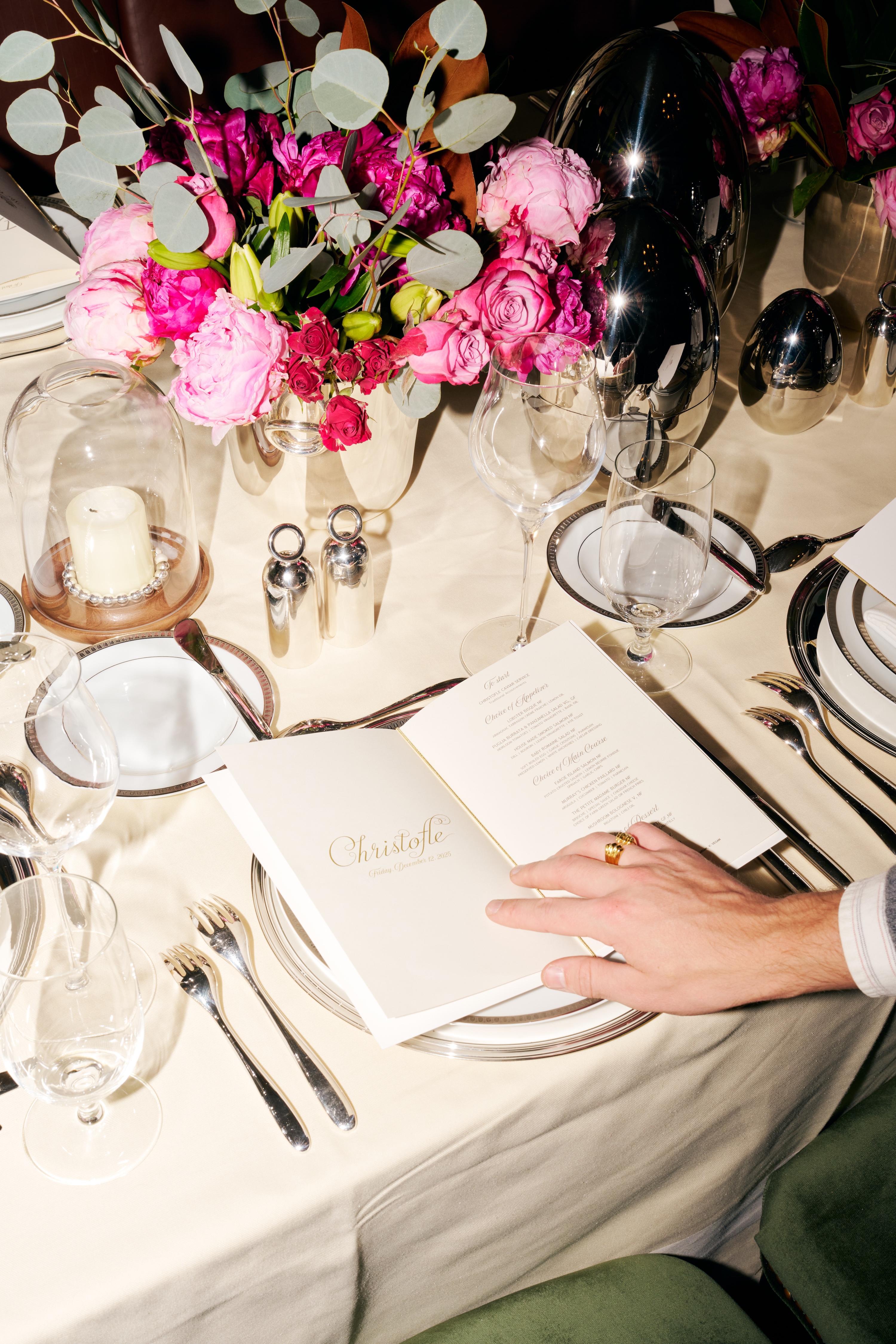

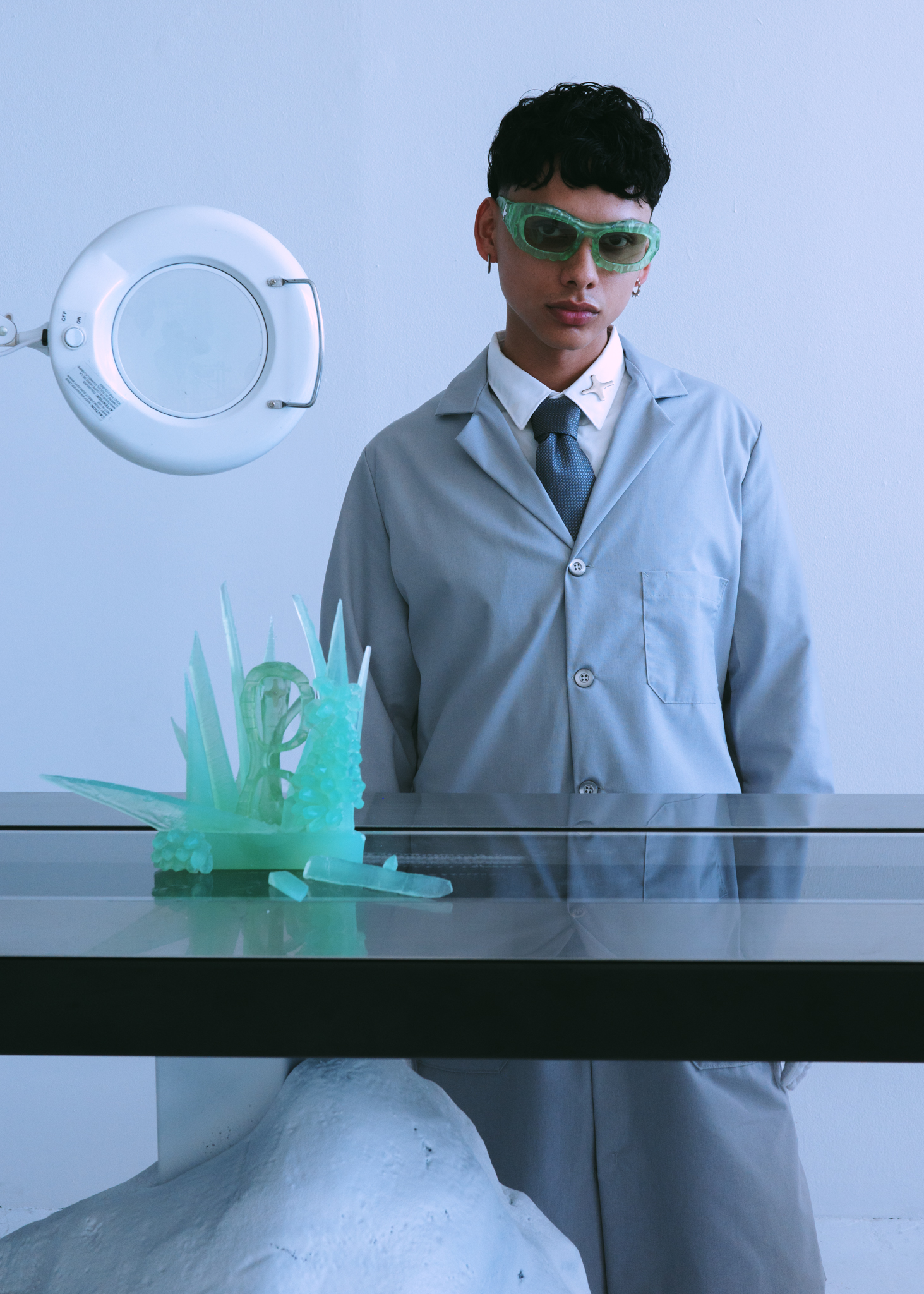

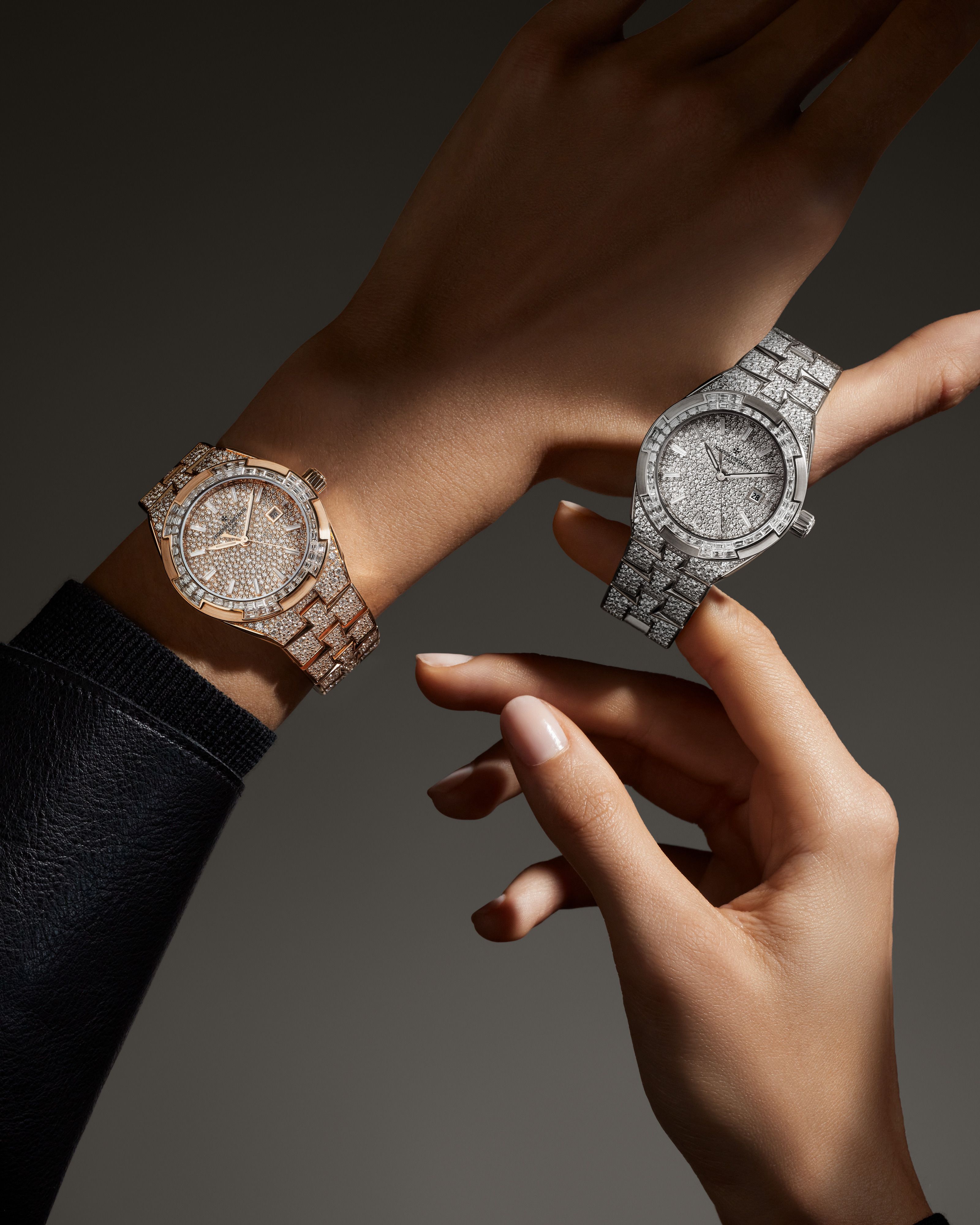

.JPG)
.jpg)
